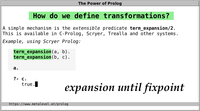Prolog Macros
| Video: |

|
Introduction
In the Lisp community, macros are always a big deal. A
Lisp macro rewrites Lisp code.
Very often, the phrase "code is data" is used in this context. But
this also holds for example for C and Java code: C code
is also data, and you can store and access C code as a
plain text file. Therefore, this does not capture the main
reason why we should care about Lisp macros especially. In a more
limited sense, a C preprocessor also supports macros.
What, then, is the core difference between Lisp and C
macros? Clearly, Lisp macros are much more powerful because
they can easily analyze Lisp code. Why is this? Because Lisp
code has a natural, structure-preserving representation as
a Lisp data structure! This is not the case for C
or Java. For example, there is no built-in data structure
in C that faithfully represents C source code in a
structure-preserving way. We can represent C
source code within C as an array of characters, but that does
not preserve the abstract structure of the source code, and
it makes basic operations extremely hard. For example:
- Which variable names occur in the program?
- How many if-then-else constructs are used in the code?
- Are there tail-recursive functions?
These are questions that are hard to answer in the case of C
because it is hard to reason about the structure of
C programs in an abstract way, at least much harder than it
is in the case of Lisp.
The point of this page is to show you that Prolog has a mechanism
that works much like macros in Lisp. In fact, macros
are a lot easier to write in Prolog for several reasons. For
example, you do not have to quote Prolog code when
reasoning about it or generating it, and you cannot
accidentally run into name clashes with different
variables. This simplicity is the main reason why Prolog
programmers are not as hysteric about this feature as several
other language communities. In Prolog, this facility is simply
available, and easily used when needed.
Code is more than data
Of course, code is data: We write it down, we read it.
Prolog code is more than simply "data" though: Every Prolog
clause is a valid Prolog term.
This is
structured data, which we can analyze and process
systematically using built-in
features of Prolog.
For example, consider a simple Prolog rule:
f(X, Y) :- g(X), h(Y).
This is the following Prolog term:
- the functor name
is :-, and the arity is 2
- the first argument of the term is the term f(X, Y)
- the second argument is the compound term ','(g(X),
h(Y)), which in turn again has two arguments.
If you are ever unsure about what a term "actually" is,
use write_canonical/1 to obtain the
term's canonical form:
?- write_canonical( (f(X, Y) :- g(X), h(Y)) ).
:-(f(A,B),','(g(A),h(B)))
In the canonical form, all compound terms are output
in functional notation.
Note that we have used parentheses around the term to properly
indicate the single argument of write_canonical/1.
Rewriting Prolog code
All widely used Prolog systems provide mechanisms that let
us rewrite Prolog code at compilation time.
The advantage is clear: We can perform complex transformations of
Prolog code once at compilation time, resulting in often
faster code at run time.
In Prolog systems, this facility is typically provided
by extensible predicates such as term_expansion/2
and goal_expansion/2. These predicates take
2 arguments:
- the first argument is a Prolog term as it occurs in the
program that is being compiled
- the second argument denotes the replacement of the term.
If a clause of this extensible predicate succeeds, then the
replacement term is used instead of the
original term during compilation.
If your Prolog system does not provide this facility, you can
easily implement it yourself, using the built-in
predicate read/1 to read Prolog terms from a file.
The exact semantics of these predicates differ between
Prolog systems, for example regarding questions such as:
- Are the virtual read-term beginning_of_file
and end_of_file made available for expansion?
- Are expansions themselves subject to expansion?
- Are meta-calls automatically expanded at run-time?
- Are queries subject to goal expansion?
- ...
A common standard would be nice.
Examples
See the implementation
of DCGs for an example of term expansion that is
used in almost all widely available Prolog systems. In this
case, the expansion mechanism is used to automatically
equip DCG rules and all DCG nonterminals with 2
additional arguments in a systematic way.
In Scryer Prolog, integer arithmetic serves
as an example of goal expansion. For instance, consider the
following Prolog rule whose body consists of a single goal:
integer_successor(I0, I) :- I #= I0 + 1.
To see how this is automatically expanded, declare the predicate
dynamic via the dynamic/1 directive, and
use listing/1 from library(format):
?- listing(integer_successor/2).
integer_successor(A,B) :-
( integer(B) ->
( integer(A) ->
B=:=A+1
; C is B,
clpz:clpz_equal(C,A+1)
)
; ( integer(A) ->
( var(B) ->
B is A+1
; C is A+1,
clpz:clpz_equal(B,C)
)
; clpz:clpz_equal(B,A+1)
)
).
This example illustrates that low-level integer arithmetic is
automatically used whenever possible, even if we use
higher-level constructs which also work in other directions.
More about Prolog
Main page

